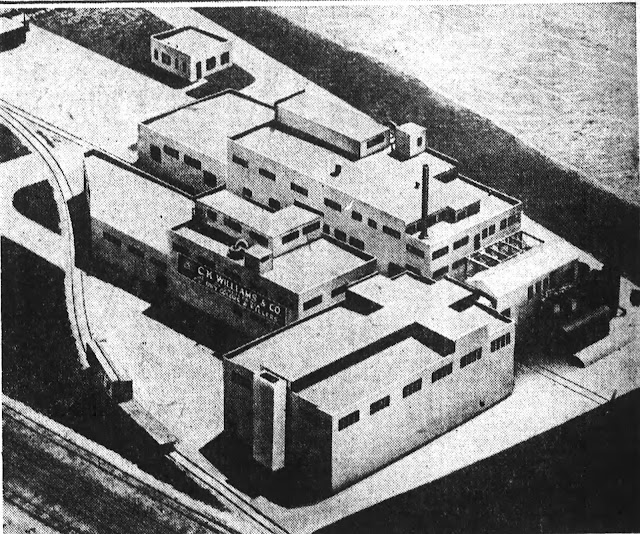For Dry-Color Manufacture
An aeroplane view of the C. K. Williams and company plant at the old Shellmound Park site. This plant is the western branch of the concern whose main establishment is at Easton, Pennsylvania. Reed and Corlett were the architects and H. A. Christensen, the general contractor for the building.
Upon the site where once the early Indian inhabitants of what is now the city of Oakland had one of their many bay shore villages, has been erected one of the most modern and finely-equipped plants for the manufacture of dry colors and fillers in the country. The plant is that of C. K. Williams & Co. of California, now nearing completion and the site is what was part of old Shellmound Park, now an industrial subdivision. This park took its name from the fact that the largest of the bay shore "shell mounds" was included in the park area.
These mounds were of the same general character as the "kitchen-middens" of other countries, and were largely composed of earth, oyster and clamshells. With the leveling of the big mound in Shellmound Park, preceding the erection of the C. K. Williams & Co. plant, the University of California made quite an exhaustive study of the contents of the mound, finding that it had served a burial place for the early Indians, a crematorium for those believing in cremation, a community fireplace, and a general dumping ground for the entire village. In addition to the human burials, the representatives of the University found the skeletal remains of many quadrupeds, birds, sea mammals, and fish. Fine ash, indicative of fireplaces, were found in a number of pockets in the mound, which led to the belief that it had served as a central location for the preparation of meals. Partially burned human skeletons showed that some of the Indians believed in cremating the bodies of the dead, though the big majority followed the burial custom.
Particularly interesting, in view of the fact that this site of the activities of the early inhabitants, was to be later occupied by the largest manufacturer of dry colors in the world, was the evidence found by the university that certain paint manufacturing operations had been carried on by the Indians. Samples of paint were frequent in the central portion of the mound and 38 lots were collected of which three were yellow paint. This was apparently the raw material from which red paint was made, for upon being heated and allowed to cool, the material became red. The paint consisted of the ordinary iron oxide used for similar purposes throughout the world, both in the past and the present.
In place of the crude use of pigments by the Indians of a century or so ago, today there is almost ready for starting operation a modern, completely equipped factory for the production of dry colors and fillers. This plant is the western branch of the C. K. Williams & Co. of Easton, Penn., erected on the site of the old Shellmound Park, and is under the management of Verne Frazee, who gives the following short history of the company:
"The business of C. K. Williams & Co. was established a half century ago, and the plant at Easton covers more than 75 acres, engaged entirely in the manufacture of the company's products. In addition to this plant, the company operates a number of subsidiary plants and mines, in fact the company owns and operates mines producing all the materials vital to the conduct of its business.
"With its main plant located on the Atlantic seaboard, the necessity of giving better service to its growing western trade forced the company to give serious consideration to the establishment of a plant on the Pacific seaboard in the later part of 1926.
"After a careful survey of possible Pacific Coast locations, Oakland was selected as being the most central and advantageous manufacturing and distributing point for serving the 11 western states. Ten acres were purchased in old Shellmound Park, now an industrial subdivision, at Emeryville, and about half of this acreage is now covered by one of the most modern and efficient plants of its kind to be found anywhere in the world. The company considers that provision has been made for the future growth of business for several years to come. With the western plant in operation and its proximity to its western customers, the company feels that entirely aside from the advantage of being in a position to give quick service to the trade, it will also be able to study local requirements and meet demands in a manner practically impossible were the eastern plant the only one.
"The Pacific Coast plant is thoroughly modern in every respect, representing the many years of experience of the parent company. The western plant will have a fully equipped laboratory, in charge of paint chemists. This laboratory will conduct research work in all kinds of manufacturing problems in the use of pigments.
"Much of the machinery being installed in the new Williams factory was designed and built especially for this plant, and the buildings are divided into separate units so as to avoid any possible contamination of manufactured products. The full capacity of the plant will approximate 40 tons a day, with 10 tons a day as the maximum at the start of operations. It is expected that the plant will be ready to start shipping sometime in August."
The Pacific Coast plant has been erected under the personal supervision of C. T. Ayers, who has been engaged in the active management of the Easton plant for the past 40 years. Verne Frazee is Pacific Coast manager for C. K. Williams & Co. of California.


Comments
Post a Comment